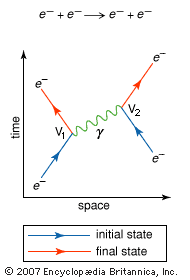Why leptons annihilation is not 4-particles, and it is represented in the form of two 3-particles? If the pair of an electron and a positron has formed a positronium particle, then what is virtual state before the formation of two photons? What is located on the Feynman diagram between the photons emission points by the electron and the positron?

Why is the formation of a virtual lepton with zero mass not shown for each photon emission at above picture from https://en.wikipedia.org/wiki/Annihilation?


